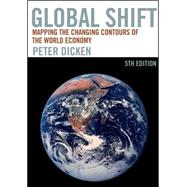This bestselling work is the definitive text on globalization. Peter Dicken provides a comprehensive, balanced yet critical account of globalization processes and their sweeping, highly uneven effects on people’s lives. Each chapter reflects current globalization and antiglobalization debates, the latest empirical developments, and new ideas about the shaping and reshaping of production, distribution, and consumption in the world economy. Of special utility are detailed case studies of key global industries and more than 250 specially designed figures and tables. To facilitate use in the classroom, the figures and tables are also available online as PowerPoint slides.








